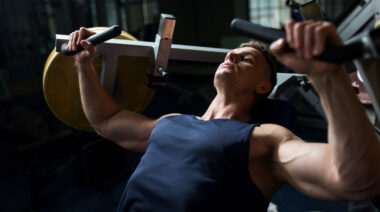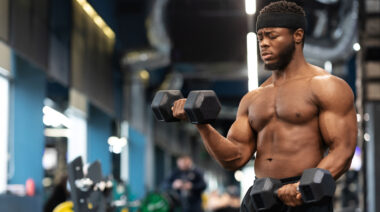With the growing popularity of CrossFit, many people over age 35 have discovered a passion for competition. Today’s over-forty population is not interested in growing old gracefully, and like their younger counterparts, once introduced to the sport, they thrive on competition.
Besides running and CrossFit, weightlifting is one of the few arenas wherein the over-forty athlete can ignite that passion for competition with loads of local meets and a well-developed masters national circuit already fully in play.
With the growing popularity of CrossFit, many people over age 35 have discovered a passion for competition. Today’s over-forty population is not interested in growing old gracefully, and like their younger counterparts, once introduced to the sport, they thrive on competition.
Besides running and CrossFit, weightlifting is one of the few arenas wherein the over-forty athlete can ignite that passion for competition with loads of local meets and a well-developed masters national circuit already fully in play.
As a fifty-year-old athlete myself (that’s me on the left), I am well aware of the toll that weightlifting can take, having suffered a fairly severe injury myself about four years ago.
However, many master’s athletes are relatively new to sport or have been away from rigorous training for decades. So what are some of the things you can do to build a stronger base while keeping alive that thirst for excellence and not detract from the movement patterns you are working so hard to ingrain? What exercises can you incorporate into regular training that will strengthen your body while handling issues associated with being older at the same time?
My Experience
I am a weightlifting coach, and my team consists mainly of athletes between the ages of thirty and fifty. Although there are a few outliers, these athletes are the ones who have heeded the call and have developed a passion for weightlifting by training with our team. These athletes are the ones I have been graced with to coach – even taking one of them to a well-fought-for bronze medal at the recent 2015 Masters Nationals in Monrovia, California.
“I sincerely believe in the power of regular chiropractic care, physical therapy, corrective movement, mobilization, stretching, and deep tissue work by qualified practitioners.”
As a fifty-year-old athlete myself, I am well aware of the toll that weightlifting can take, having suffered a fairly severe injury myself about four years ago. Since then, I have spent a lot of time reading, learning, and even experimenting on myself to uncover effective exercises, stretches, and mobilization tools to help my team perform better with less pain, better movement, and no injuries.
No Coach Is an Island
Let me first say that I firmly believe in referring out. No coach is an island with all of the answers. I sincerely believe in the power of regular chiropractic care, physical therapy, corrective movement, mobilization, stretching, and deep tissue work by qualified practitioners. In fact, the exercises incorporated into this program design were vetted by Yvonne Ramirez, PT, DPT and Michael Shahbazian, DC. Matt LaBosco of Optimal Performance Systems was also consulted regarding some of the ideas incorporated. I highly recommend any of these professionals, as they have all helped me and members of our team to move and perform better.
As Matt LaBosco likes to say, “The thoracic spine, hips and feet/ankles are the 600 horsepower engines of your body. If you don’t keep those fully operational, the low back and knees take the brunt of where they fail.” As such, keeping the big engines in excellent working order is the overriding principle behind the exercises and mobility included in this program’s design.
“This program would be suitable for the following weightlifters: Class III, Class III Masters, or athletes new to the sport of weightlifting but who have a good understanding of how to do the lifts, albeit still needing practice in perfecting form.”
I’ve opted to use as a base Bob Takano’s Sample Class III Training Program from his book Weightlifting Programming: A Winning Coach’s Guide, as I feel what I’d like to highlight is what I add or subtract, as I in no way can compete with Bob’s brilliance when it comes to writing weightlifting programming. Although Bob gave me his permission to use this, my additions and subtractions are mine and mine alone and should not be taken in any way as endorsed by Mr. Takano.
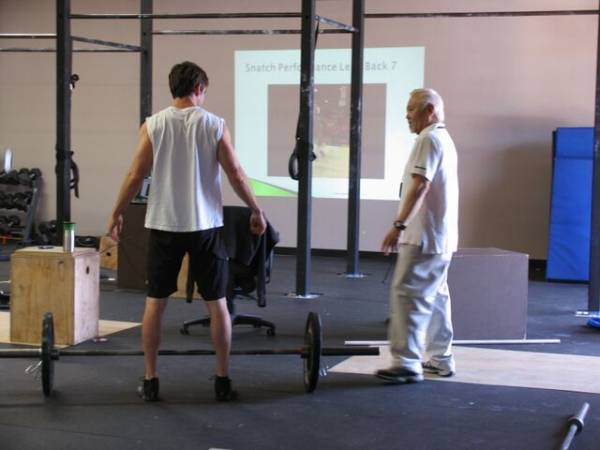
Bob Takano coaches during a clinic in Santa Barbara, California.
Who This Program Is For
This program would be suitable for the following weightlifters: Class III, Class III Masters, or athletes new to the sport of weightlifting but who have a good understanding of how to do the lifts, albeit still needing practice in perfecting form. It is meant for people who need some GPP, but who have been doing some sort of regular athletics for at least six to nine months, can move with decency, have a good idea of their bodies, and present no obvious injuries or issues.
Although some general short conditioning would normally be included as part of the GPP training for this population, as well as a fairly extensive mobilization plan, this article and program will focus on the auxiliary exercises we incorporate and their purpose in this program. We’ll talk more about the mobility side of things in my next article.
Below are the supplementary exercises we include with the programming for these lifters:
- Building Core Strength: Incorporating planks, side planks, Pallof presses, dead bugs variations, leg lowering, hanging straight leg raises, and hollow holds helps ensure a stronger trunk on which to hold heavier weights while squatting, as well as better bracing for powerful extensions in weightlifting. These variations can be progressed as the athlete achieves mastery.
- Strengthening the Low Back: All of the core strength exercises are incorporated with protecting the low back in mind. Weightlifters often develop the low back extensors without developing the surrounding musculature simultaneously. Our focus on a strong core is with prevention in mind.
- Increasing Thoracic and Scapular Mobility: Incorporating slow scapular push-ups, thoracic foam rolling, wall angels, and ring flex arm hang with knees up really forces scapular retraction and separation as well as keeping the thoracic spine moving. Bat wings, with the emphasis on rhomboid retraction, help build strength endurance and improve posture.
- Keeping the Shoulders Healthy: The thoracic mobility work’s main purpose is to strengthen the posture and mobility of the thoracic spine, so the shoulders won’t have to bear their load. However, strengthening all of the surrounding musculatures of the shoulders is also critical. Incorporating bent flyes with external rotation (which also target the rhomboids) pull-ups, cross-body stretches, bat wings, deep tissue work (especially on the neck), and even internal rotation exercises has proven beneficial.
- Improving Hip and Glute Mobility: Bridges, hip flexor stretches, the leg lowering portion of the side planks, bowler squats, and reverse tables are all incorporated. Deep tissue work for tight hips is also critical to keeping the hips fully functional, so the low back doesn’t try to do their job.
- Mobilizing Ankles and Feet: Dorsiflexion stretches with plates or bars held at the knees are standbys for weightlifters, as it is well documented how lack of ankle mobility affects the squat. Incorporating ankle extension stretches has shown helpful in keeping this area mobile, and arching and flexing the feet has also proven therapeutic.
8-Week Masters Weightlifting Program: Week One
Please note that all 1RMs are projected. That is, the percentages are based on a 1RM the lifter expects he or she will be able to hit at the end of the program.
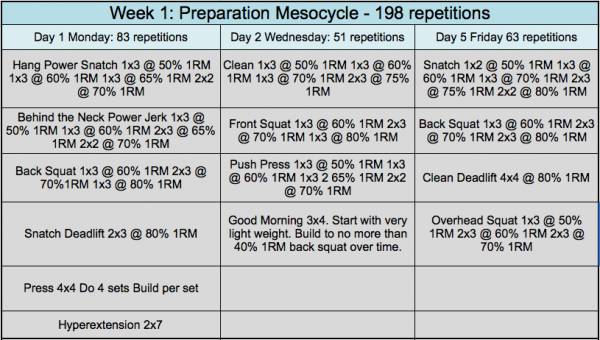
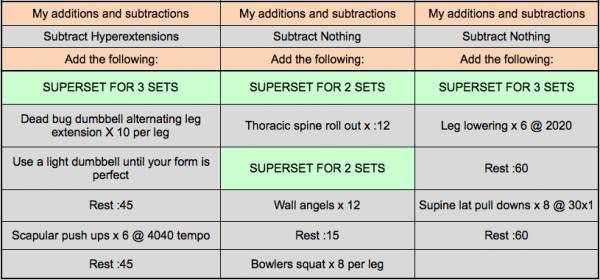
More Like This:
- What Makes Masters Competition Different From Regular Competition?
- Train to Win in 24 Weeks: Masters Swimming and 5K Running Events
- Women and Weightlifting (And How I Fell in Love)
- New on Pulse Beat Fit Today
References:
1. Stuart McGill, Low Back Disorders, Evidence-Based Prevention and Rehabilitation, Second Edition (University of Waterloo, 2007), 210-241.
2. Bob Takano, “Weightlifting Programming: A Winning Coach’s Guide”, (Catalyst Athletics, 2012), 70-74.
3. Eric Cressey, “Lower Back Savers,” last modified 05/05/09.
4. Dan John, “Reawaken Your Rhomboids”, T-Nation. Last modified 4/19/11.
5. Mike Robertson, “Ground Based Core Training”, Mike Robertson, last modified 10/9/13.
Click on the number below that corresponds to the week of training you’re in.
8-Week Masters Weightlifting Program: Week Two
Please note that all 1RMs are projected. That is, the percentages are based off a 1RM the lifter expects he or she will be able to hit at the end of the program.
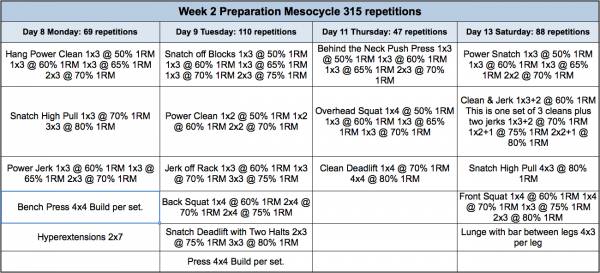
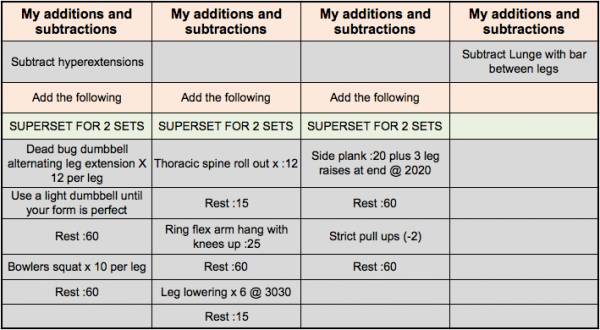
Click on the number below that corresponds to the week of training you’re in.
8-Week Masters Weightlifting Program: Week Three
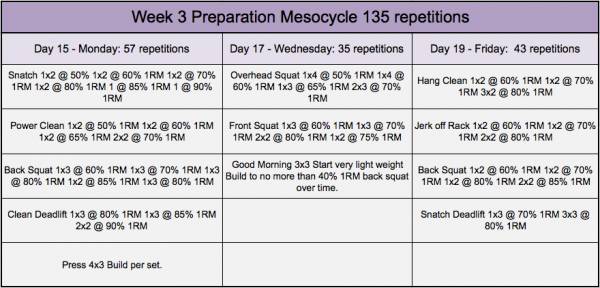
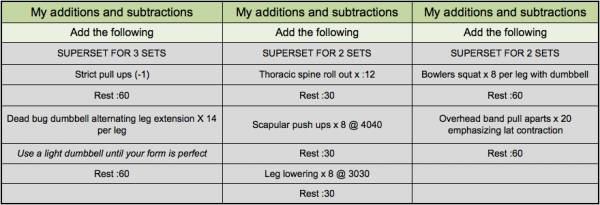
Click on the number below that corresponds to the week of training you’re in.
8-Week Masters Weightlifting Program: Week Four
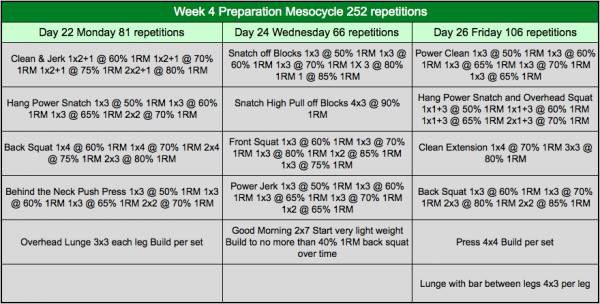
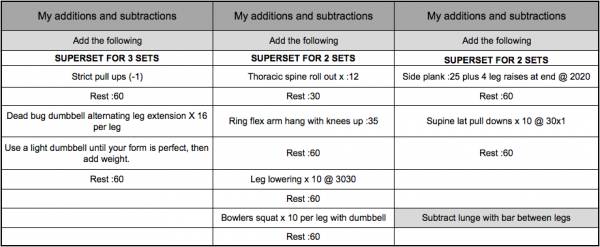
Click on the number below that corresponds to the week of training you’re in.
8-Week Masters Weightlifting Program: Week Five
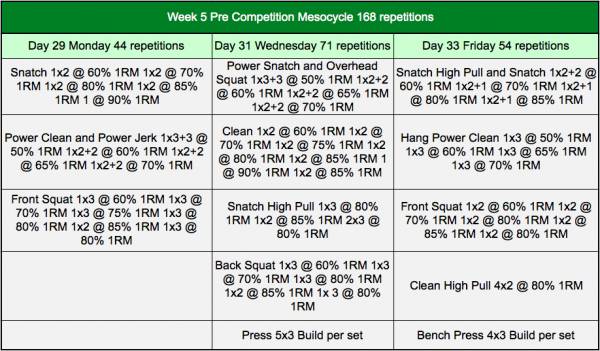

Click on the number below that corresponds to the week of training you’re in.
8-Week Masters Weightlifting Program: Week Six
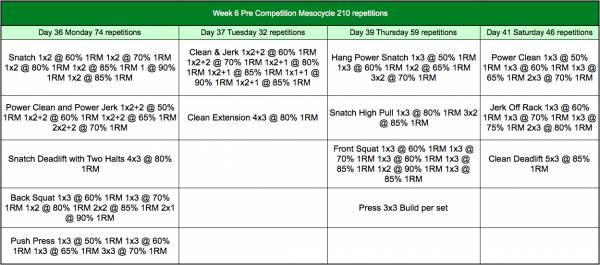

Click on the number below that corresponds to the week of training you’re in.
8-Week Masters Weightlifting Program: Week Seven
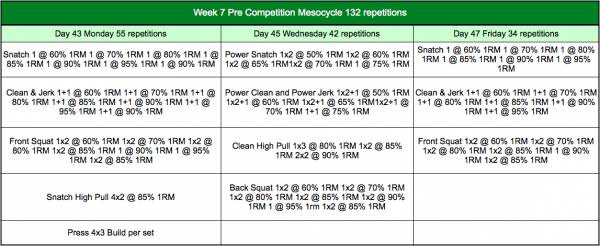

Click on the number below that corresponds to the week of training you’re in.
8-Week Masters Weightlifting Program: Week 8

Click on the number below that corresponds to the week of training you’re in.

